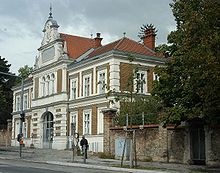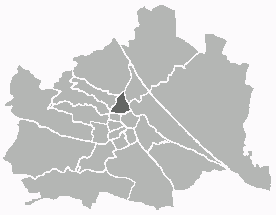
Alsergrund is the ninth district of Vienna, Austria. It is located just north of the first, central district, Innere Stadt. Alsergrund was incorporated in 1862, with seven suburbs. As a central district, the area is densely populated. According to the census of 2001, there were 37,816 inhabitants over 2.99 square km.

Hernals is the 17th district of Vienna, Austria . Hernals is in northwest Vienna. It was annexed in 1892 out of the townships of Hernals, Dornbach, and Neuwaldegg.
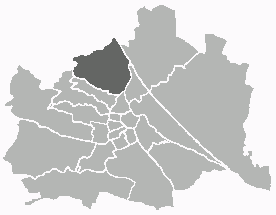
Döbling is the 19th district in the city of Vienna, Austria. It is located in the north of Vienna, north of the districts Alsergrund and Währing. Döbling has some heavily populated urban areas with many residential buildings, and borders the Vienna Woods. It includes some of the most expensive residential areas such as Grinzing, Sievering, and Neustift am Walde, and is home to many Heurigen taverns. There are some large Gemeindebauten, including Vienna's most famous, the Karl-Marx-Hof.

Ottakring is the 16th District in the city of Vienna, Austria. It is located west of the central districts, north of Penzing and south of Hernals. Ottakring has some heavily populated urban areas with many residential buildings. It was formed from the independent villages of Ottakring and Neulerchenfeld in 1892.

Liesing is the 23rd district of Vienna. It is on the southwest edge of Vienna, Austria.

The Museum of Military History – Military History Institute in Vienna is the leading museum of the Austrian Armed Forces. It documents the history of Austrian military affairs through a wide range of exhibits comprising, above all, weapons, armours, tanks, aeroplanes, uniforms, flags, paintings, medals and badges of honour, photographs, battleship models, and documents. Although the museum is owned by the Federal Government, it is not affiliated with the Federal museums but is organised as a subordinate agency reporting directly to the Ministry of Defence and Sports.

Neudeggergasse Synagogue was a Jewish synagogue in Vienna, Austria.1 The synagogue served the Jewish community of the VII. and VIII. Districts . It was commissioned by Baron Moritz von Königswarter, and the architect was Max Fleischer.

Herzogenburg Monastery is an Augustinian monastery located in Herzogenburg in Lower Austria. Founded in 1112 by Augustinian Canons, the monastery was refurbished in the Baroque style in 1714 by Jakob Prandtauer, Johann Bernhard Fischer von Erlach, and Josef Munggenast.
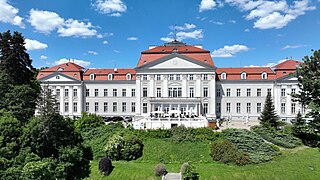
Wilhelminenberg Castle is a former palace dating from the early 20th century, which is now a four-star hotel, restaurant and conference facility. It is situated on the eastern slopes of the Gallitzinberg, in the Wienerwald western parts of the Austrian capital, Vienna.

The Gaugefechtsstand Wien was a World War II subterranean command bunker situated in the densely forested Wienerwald western parts of Ottakring, the 16th district of Vienna. Commonly known as the Schirach-Bunker, the facilities were constructed between 1942 and 1945 as a massive underground extension to barracks that had been established in 1940.

The Kuffner observatory is one of two telescope-equipped public astronomical observatories situated in Austria's capital, Vienna. It is situated in the West of the city's Ottakring district, on the slope of the Gallitzinberg at 302 m altitude. Originally a private research institution, it was converted into an educational astronomy facility after World War II as buildings and city lights had encroached to a degree that severely hampered scientific nightsky observations. Today the main tasks of the observatory consist in public education on astronomy, operating and preserving the historical equipment, and minor projects in scientific astronomy.
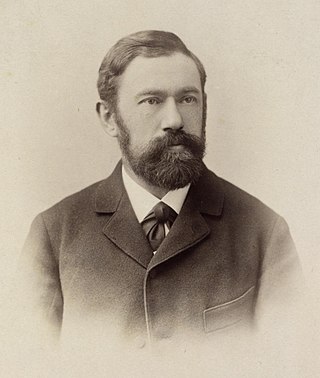
Moriz von Kuffner was a Jewish-Austrian industrialist, art collector, mountaineer and philanthropist. From the 1880s to the early 1910s he made a fortune in the brewery business, and became a significant sponsor of Vienna's social and cultural life as well as a mentor of astronomy. Moriz von Kuffner was forced to sell his Austrian assets and to leave Vienna in 1938.

The Habsburgwarte is a 27 metre-tall tower that stands on Hermannskogel hill in Vienna. It was built by architect Franz von Neumann to resemble a medieval tower.
Predigtstuhl is German for "pulpit", but may also refer to:

Franz Rumpler was an Austrian genre and landscape painter.

Johann Nepomuk Berger was an Austrian lawyer, politician and writer.

The following outline is provided as an overview of and topical guide to Vienna:

Georg Decker was an Austro-Hungarian portrait artist.

Viktor Matejka was a Viennese politician and writer.

Jakob Moritz Grün was an Austrian violinist of Hungarian origin. After positions as principal violinist in the court orchestras of Weimar and Hannover, he was, from 1868 to 1897, concertmaster of the Vienna Court Opera Orchestra. He taught notable players at the Vienna Conservatory from 1877 to 1908, including 20 future orchestra members, as well as Carl Flesch and Franz Kneisel.




